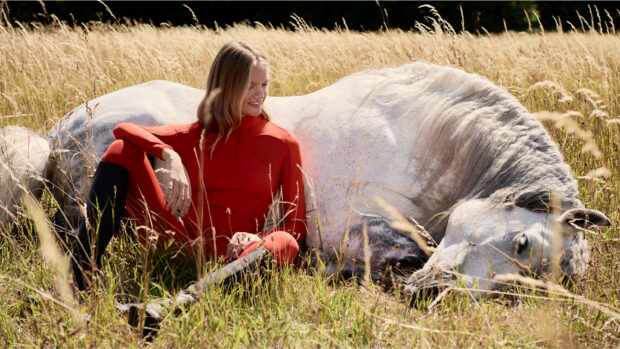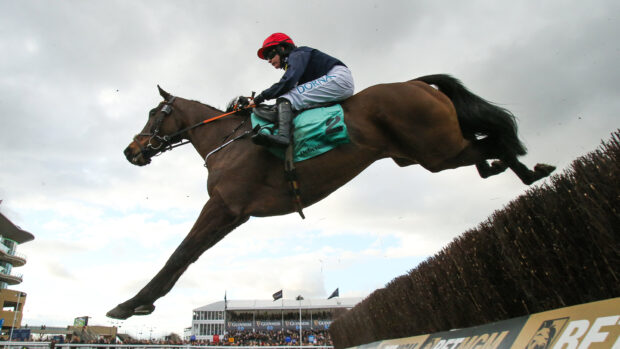Most owners will need to use a hose on their horses at some point – whether that’s to wash them down after exercise during warm weather, or if they pick up an injury that requires cold hosing, but not all horses enjoy the experience and can be fidgety. So Jason Webb, who runs Your Horsemanship, which specialises in starting young horses under saddle and retraining horses with behavioural and ridden problems, offers his expert advice on teaching a horse to stand while being hosed to make life easier for both you and your horse.
Teaching a horse to stand while being hosed: advice from an expert
Jason says that “there really is a simple answer to solving this problem” and it starts with being able to control your horse’s body and feet.
“Firstly, I need to be able to move my horse’s hind end around me,” he explains. “Then I need to be able to keep my horse out of my personal space.”
Jason says that it is important anything new to the horse is introduced with consistency.
“I see a lot of people introducing the horse to a hose by turning it on, and just letting it run by them for a little bit and letting them look at it. Eventually your horse will become familiar with it, but for some horses that’s only OK if you leave it near them and don’t bring it any closer.”
However, this can prove problematic as you try to progress with teaching a horse to stand while being hosed by bringing the hose closer.
“When a horse is looking at something they’re not sure about, they will exercise a little bit of caution and tend to move away from it,” says Jason. “What tends to happens when your horse reacts negatively is that the handler either takes the horse away from the hose, or takes the hose away from your horse.
“The problem with this response from the handler is that your horse gets to relax when moving away from the object, so the next time you present the object, your horse will move away, knowing that you will allow them to do so and that takes the pressure away from them.”
Jason recommends the best way to teach a horse to stand while being hosed starts by lengthening out the hose so that it is lying flat on the ground.
“I then direct my horse in a really small circle stepping over the hose to the left and then one circle stepping over the hose to the right,” says Jason. “Once my horse is comfortable about stepping over the hose, I turn the hose on and I put my finger over the end of the hose so creates a fan-type spray. Then I turn it on – my horse may look at it and be a little bit worried, but I will be prepared to direct my horse around the circle I’ve just taught them, so they are moving around me rather than pulling away.”

Hose Spray Gun | Amazon
This hose gun has 10 spray settings so you can introduce your horse to the water at his own pace.

Shampoo Hose Gun | Amazon
This hose gun has a compartment that premixes your shampoo so there is one less thing to think about. Eight spray modes.
Jason suggests initially directing the hose on to the least sensitive area of the horse that you can access, which in this case is their shoulder.
“I start with a nice even, gentle spray and I put it straight onto the horse’s shoulder. They may jump a little, in which case just allow your horse to move around for one circle, while keeping the spray on them. They might start a little bit flighty, but then they’ll realise that it’s just water and start to slow down in their movement and start to relax.
“As they start to relax, they’ll eventually stop. At the point where they stop, take the hose away from them. What this does is it teaches your horse that if they stop moving, the hose goes away.”
Once this step is mastered, Jason recommends moving the hose into a slightly different position so you can spray the other shoulder.
“Prepare yourself again, and have the hosepipe at an angle so that your horse will most likely move forward and around the circle again. If they go backwards, just keep the spray on until they stop going backwards, then take it away, bring the horse back to where you started and repeat the process.”
Jason says once you can spray your horse’s shoulders on both sides with them standing still, to end the session for that day.
“The next day I use the same process to do the other parts of the horse’s body. When it comes to the legs, I spray the legs until the horse puts their foot on the ground and is not moving, then I take the spray away.
“By following these steps, your horse will very quickly learn to stand still patiently while you hose them off.”
You may also be interest in…

How to teach your horse to stand still for mounting

Natural horsemanship: ‘just good, common sense horsemanship’ or something else?

How good is your bath-time game? Here’s the best way to wash horses…

Groundwork for horses: what it is and why it’s useful

Horse & Hound’s beginners’ guide to clicker training

Subscribe to Horse & Hound magazine today – and enjoy unlimited website access all year round
Horse & Hound magazine, out every Thursday, is packed with all the latest news and reports, as well as interviews, specials, nostalgia, vet and training advice. Find how you can enjoy the magazine delivered to your door every week, plus options to upgrade your subscription to access our online service that brings you breaking news and reports as well as other benefits.




